Blog post by Erica Waasdorp, Charity How to Presenter, Author, Blogger and Nonprofit Library Contributor
I grew up with and in direct mail. I was fortunate to work at Reader’s Digest (RD) in Amsterdam right after college and it really shaped the rest of my career. I’ve always loved direct mail because you can measure results, but nothing beats seeing the boxes and boxes filled with responses coming back.
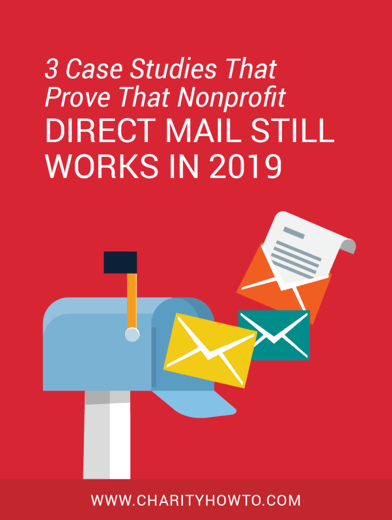
I was ‘hooked’ on direct mail and all of us direct mail ‘nerds’ at RD loved recieving the latest direct mail samples sent to us from countries like the U.S. Australia, Canada etc.
The general rule of thumb was that if direct mail packs worked in those countries, they’d most likely also generate high responses in the Netherlands. But EVERYTHING had to be tested first, that was the RD rule.
Years later, when I moved to the U.S., I was fortunate to continue my direct mail career working at and with nonprofits. We were always looking to create the latest direct mail case studies, using tests when and wherever possible, evaluating results and learning from them to create the next successful nonprofit direct mail campaign.
I’m still working with nonprofits, looking to create direct mail success stories.
What makes for a successful nonprofit direct mail case study?
You’d think the answer would be easy. If your direct mail campaign raises more money than it costs to send it out. The actual cost of the package is much less relevant than the return on investment or the cost to raise a dollar.
There are two ways to calculate the return on investment and both are commonly used in nonprofits.
Let me give you an example. If it costs $5,000 to send out an appeal and you raise $25,000.
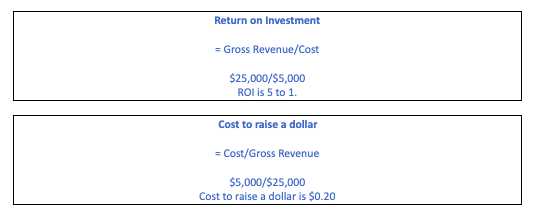
Right now, the above numbers are industry average. Let’s have this sink in for a minute. You invest $5,000 and you get $25,000 back!
Where do you see that in the stock market? (And right now, the market is doing well!).
I know organizations typically look at the cost of the package, and I understand that. And yes, postage has gone up and printing costs as well, so it’s a hard decision at times. But if you can quintuple your investment, it may be a bit easier to consider continuing direct mail in your mix, right?
Aren’t online appeals cheaper and successful?
Yes, it’s cheaper, but they do not garner a higher response. I’ve heard direct mail statistics claiming a 600 to 6000 times higher response rate than online campaigns.
Online one-time donations were down last year (monthly giving revenue was the only area of growth online). Less than 10% of gifts came in online last year. That means more than 90% came in offline. See the chart below.
What does that look like for your organization and your donors?
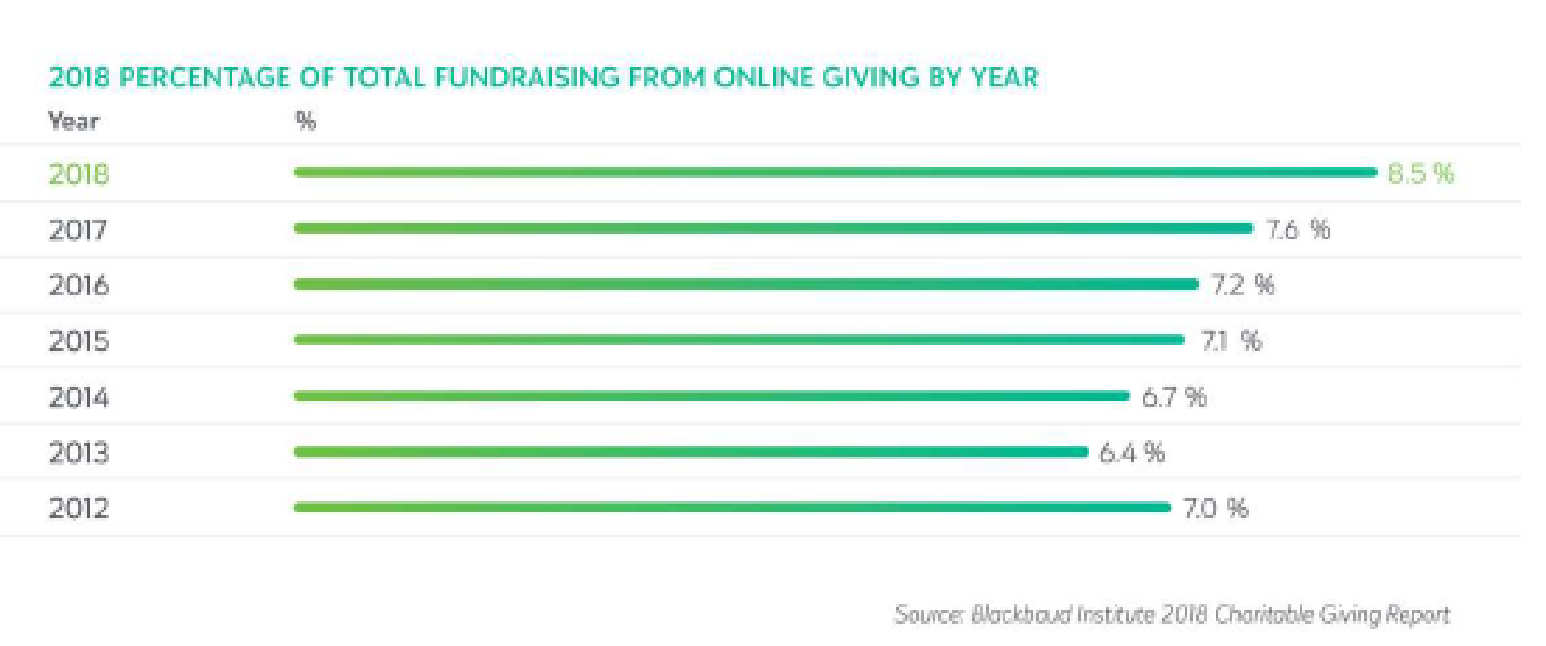
Because of the number of donors who are now giving online, I always recommend looking at your results in both channels. Most organizations see a spike in online gifts just after they mail a direct mail appeal, especially if you’re sending out a prospecting piece to generate new donors. Some organizations are very particular about tracking back those new folks to the mailing lists they targeted.
Donors would not have gone online to give if It wasn’t for direct mail, so you need to take both giving channels into account.
Direct mail case study: It’s all about segmenting your donors!
50% of results of your direct mail appeals come from whom you’re mailing your appeals to. Let me repeat that: fifty percent! This hasn’t really changed much since I got started in direct mail, it’s always been the most important driver of direct mail success.
I typically spend most of my time working with my clients on their segmentation, ask approaches and tracking. Let me share an example with you:
A new executive director joined this human service organization. Unfortunately, results of historical organizational appeals were impossible to come by. We were able to find out how much money was raised, but there was no record who was targeted and how many pieces were sent.
We basically had to start from scratch. I normally like looking at the Recency, Frequency, Monetary value report if the donor base has it. If not, I recommend doing an export of your donor base using the fields as indicated in the image below.
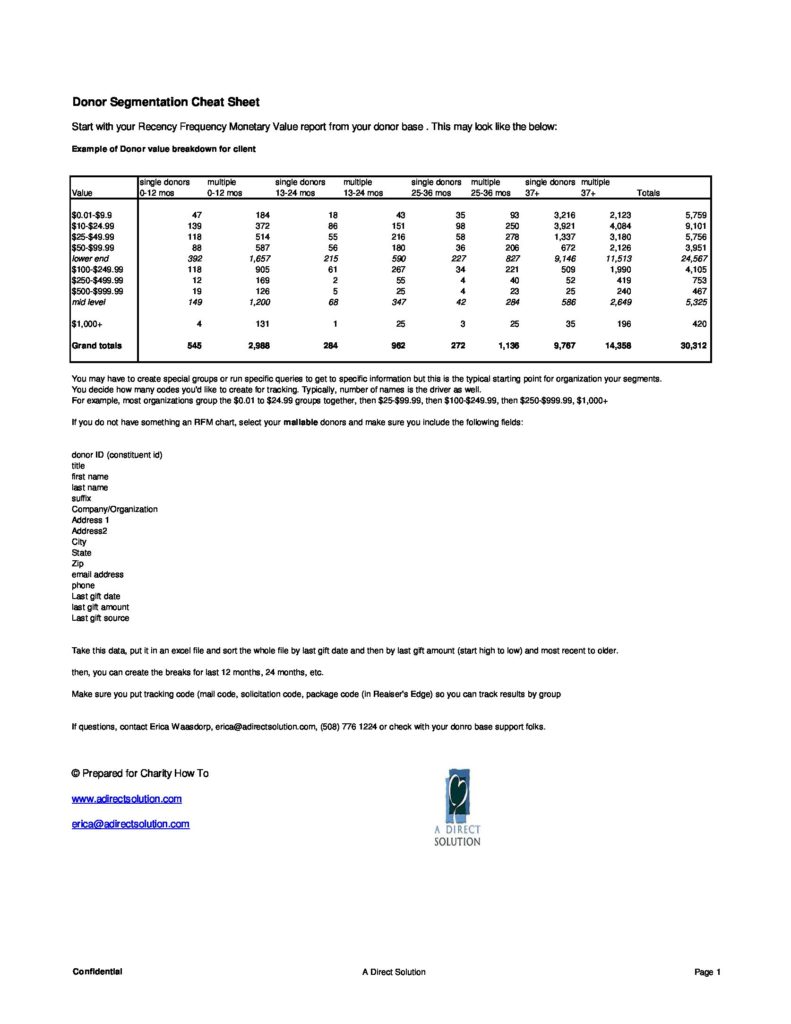
In this case, we exported the whole database and then divided it into sections. We first broke out the donors who had given a gift of $250 at some point. These donors were going to receive the same appeal as the others, but additionally the new executive director was going to handwrite a personal note on each letter and then send it out in first-class mail from the office.
All other donors were broken out by recency. We consider 0-24 months donors the ‘active’ donors and broke them out by those below $100 and those between $100 and $249.99. Next, we broke out lapsed donors, which for this organization were defined as those donors who hadn’t given in the last 3 to 5 years. Finally, we created a deep lapsed segment of those donors who hadn’t given in 5 years or more.
Then we mailed all segments with a personalized letter and personalized reply form so we could track each segment and their responses.
The results were simply astounding. Overall cost to raise a dollar $0.04!! (Remember, industry average is $0.20 for donor appeals). Even their lapsed and deep lapsed donors made money, which is unusual.
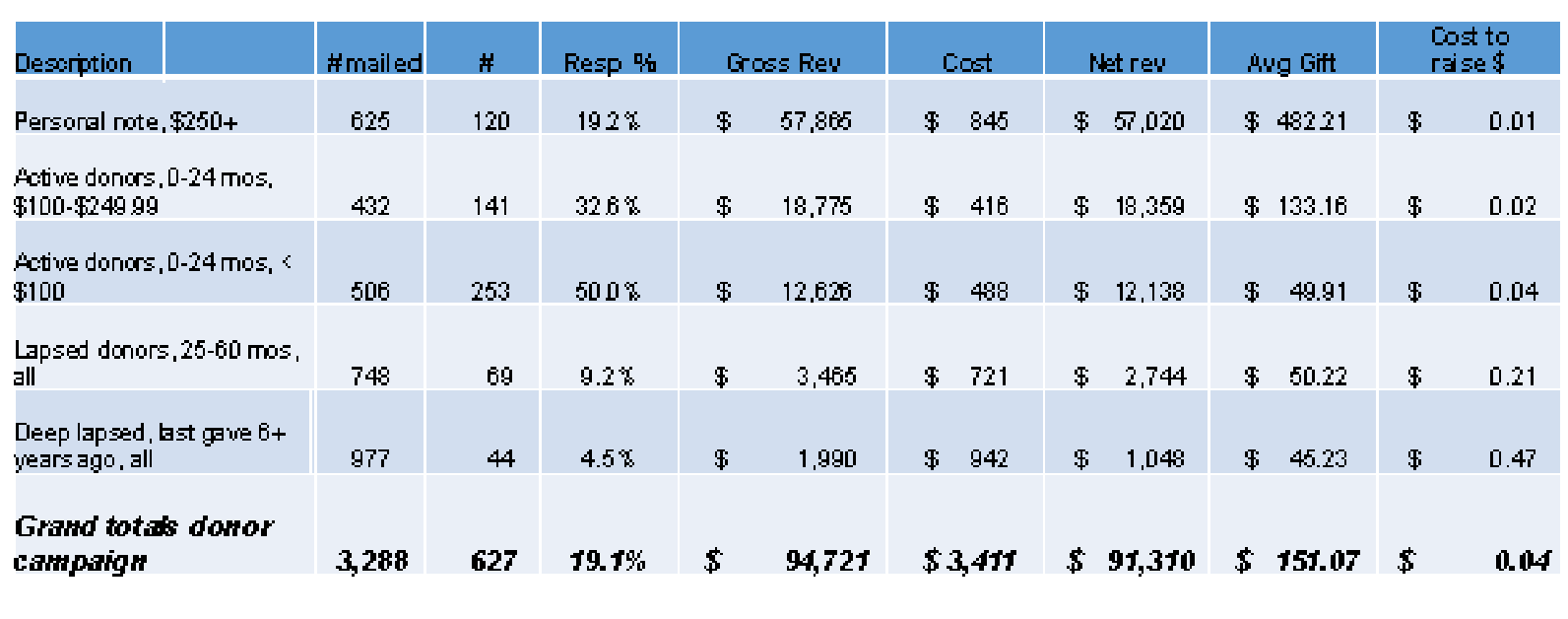
So, what can you learn from this?
If you’re joining an organization and you’re not sure what happened in the past, start by creating a benchmark and mail all mailable names to see how much money you can raise.

What about lapsed donors?
I could write several blogs about this topic. One of the things I often hear is that organizations consider donors lapsed way too soon. Many even consider donors lapsed if they’ve not given in a year.
The question I’d first ask you is: how often are you sending appeals to your donors? If you’re only mailing once or twice like so many still do, you’re not giving your donors many opportunities to give so chances they’re starting to lapse are high.
Penelope Burk’s Donor surveys show that donors don’t consider themselves lapsed at all, it’s just something we fundraisers do. You’re not saving that much money by taking them out of the direct mail stream too soon.
As you can see from the above direct mail case study, this organization was able to bring back many of their lapsed donors just by sending them an appeal. I always recommend mailing to your lapsed donors at least once a year, preferably in the fall. Look at your numbers and include them with a special segment code for tracking and you’ll know how your organization’s lapsed donors are faring.
How often should you mail? Another case study of increasing the number of direct mail appeals.
Just because you’re in charge of the annual fund, doesn’t mean that you should only appeal to your donors once a year. I typically recommend appealing to your donors at least four times a year and depending upon how many stories you have and if you also send newsletters, you can absolutely reach out even more than that.
Remember, every time you appeal, you may see a cost to raise a dollar of $0.20 so you’re making more money to help you with your mission. In fact, even if it is starting to cost a bit more, like $0.35 to $0.50, it still doubles your investment, still way better than the stock market.
Let’s look at this case study. A homeless shelters executive director was adamant about not wanting to mail more than twice a year, even though they had some 65+ homeless people they were supporting each day. Of course, they needed to raise more money, so we tried adding two appeals a year.
People only give money when you ask them!
Here are the results. Adding two appeals a year added cost, but it also increased their net revenue by 32% so it was totally worth it. Cost to raise a dollar before with two appeals was $0.12, and now with 4 appeals went up to $0.20.
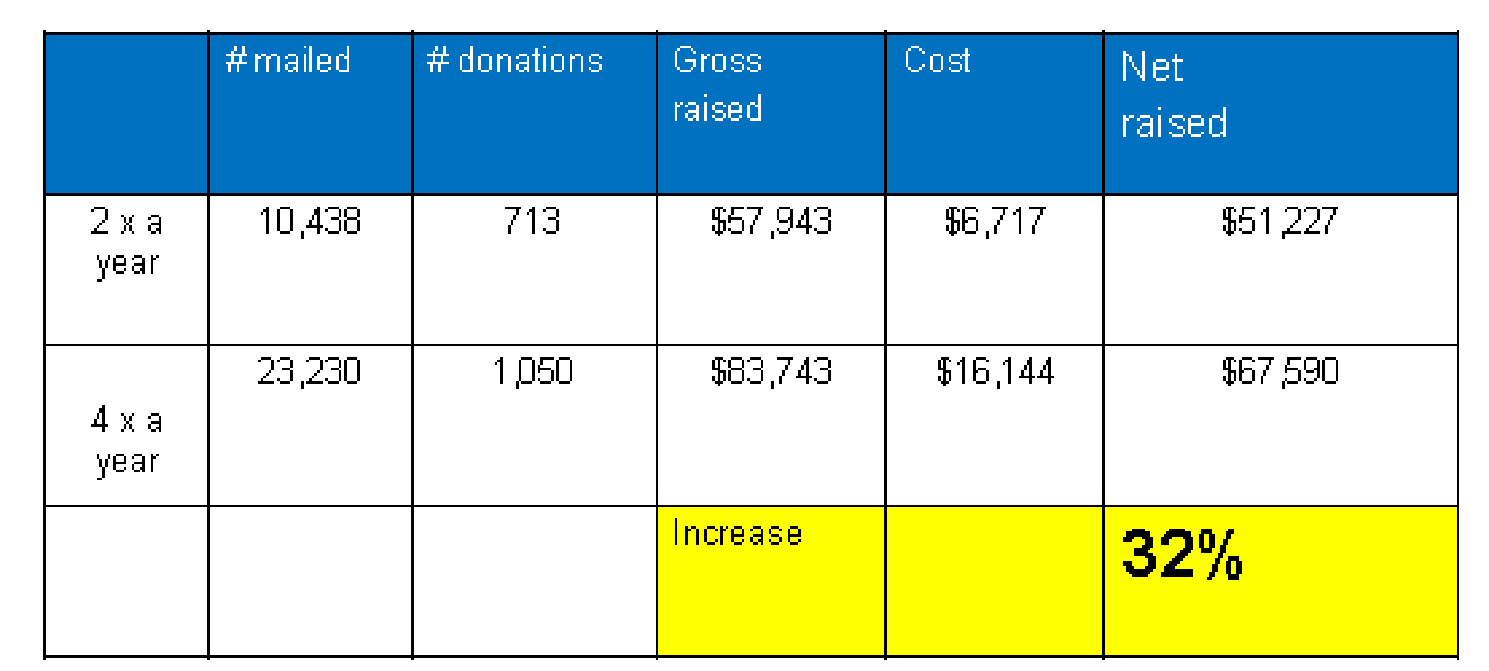
How about donors who most recently gave? Another direct mail inspiration idea..
Of course, this too depends on how often you appeal to your donors. Some donors, especially those who give larger amounts, you may wish to treat them slightly differently. Send them an appeal with a personal note, thanking them for their gift and indicating that you’re just sending them the latest appeal for their information (even though of course you’re going to include a reply envelope!).
Donors who gave most recently are most likely to give again. I’ve been able to test this time and time again.
If you’re not sure, include the most recent donors (0-3 months or 0-6 months) in your appeal and give them a special segment code for tracking and see what happens. Does the group make money? You’ll find that they typically do!
This environmental organization was hesitant about mailing too soon. They typically mail about 5 times a year and once someone reached the $1,000 level, they go into a personal note stream.
So, we started tracking the groups and you’ll find the results below. And you’ll see their lapsed donor results as well. All segments made money and their recent donors gave at substantial levels too.

How about postcards?
Based upon the fact that more than 90% of donations come in offline, in a reply envelope, I would not go to the postcard approach for direct mail fundraising appeals. It’s all about convenience. Give your donors a reply form and a reply envelope and they’ll use it, even if they have to put a stamp on it.
Nonprofit Direct Mail Campaigns are Alive and Well
Direct mail effectiveness is far from dead yet and we’ve clearly see an uptick. Even younger donors like receiving it.
Combine your direct mail with online and social media approaches and track your results by looking at both postal responses and online responses and you’ll do better than ever before!
If you’re looking to find out more about the nuts and bolts of direct mail and the latest results, statistics as well as production and creative guidelines, join me at an upcoming Charity How To webinar.
About The Author
Building partnerships and trying to find the best solution for donors and her clients are what Erica Waasdorp does best. Her multi-lingual skills and multi-cultural experience bring added value to those clients interested in raising money internationally. And her experience in monthly giving has given her an edge for those clients who are ready to embark on this way of giving.
View all webinars from Erica Waasdorp here.
For Further Reading
PS: For other idea’s on how to succeed in nonprofit direct mail, check out these articles by our friends at:
